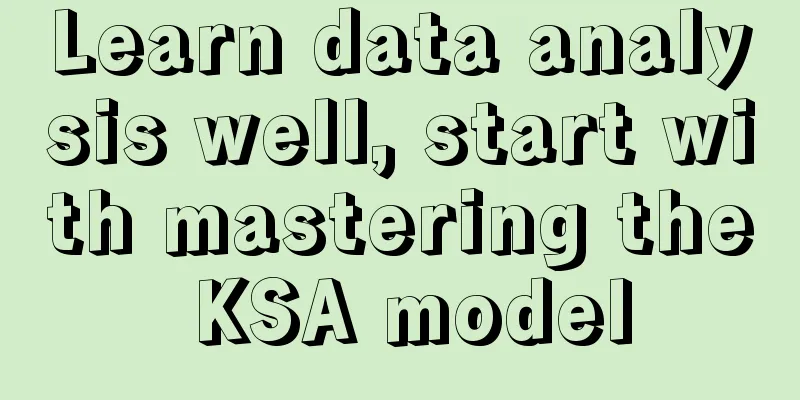Learn data analysis well, start with mastering the KSA model

Many students will think: I want to learn data analysis well, do a good job/find a good job. How can I learn it well? Here we recommend the KSA method, clarify the goals, and break down the tasks. What? You said you haven't heard of it before? Today we will explain it systematically. 01 What is KSAKSA is a concept in the HR field. It originally refers to the three dimensions of evaluating people's abilities.
Let's take a simple example. Coco, a 4-year-old child in Teacher Chen's family, is learning arithmetic:
In simple terms: ▌ Knowledge can be memorized and has objective evaluation criteria. If it is natural science knowledge, it is very likely that there is a single correct answer. Social science knowledge may not have a single answer, but there are conventional understandings and explanations within a certain range. ▌ Skills require operation, practice, and repeated training to master. Skills are based on knowledge and need to be realized with the help of tools. Different tools require different skills. The more powerful the tool, the better the effect. For example, Coco, who has learned various addition, subtraction, multiplication and division problems, turned around and asked Siri, and Coco said that the experience was good. ╮(╯▽╰)╭ ▌ Ability requires knowledge and understanding! Interestingly, when facing practical problems, understanding, communication, empathy, and coordination are often more effective than knowledge and skills! For example, when asking children questions in front of relatives, the fundamental purpose is to show off and to gain face. At this time, the children who can actively cooperate are good children! Otherwise, no matter how much you learn and how capable you are, it will still be embarrassing if you can't use your strength. This theory was originally a method for HR to evaluate the qualifications of employees. But once you master it, you will find that it is very useful in your work! Because at work, being able to clearly distinguish which KSA is needed to solve the problem can greatly improve work efficiency and promote work quality. 02 What are KSAs at work?For example, when you start to use KSA to disassemble your work, you will understand many problems in seconds, such as: Why do people always complain that liberal arts are useless in college and science is useful? It is because of the difference between KSA in education and work (as shown below): Why do professional managers in many large companies seem to be incompetent and do nothing, but still succeed smoothly? Essentially, it is because KSA has different ways of applying in achieving goals (as shown below): Therefore, understanding the principles of KSA and mastering the method of breaking down KSA are very meaningful for working in the workplace, especially for data analysis work! 03 Why KSA is important for data analysis job huntingIf applied to data analysis, KSA is reflected in:
Interestingly, if you study it carefully, you will find that among all kinds of jobs, data analysis is the only job with a full knowledge base of KSA. Generally speaking: business jobs, such as sales, products, operations, and marketing are more A-oriented and have relatively fewer KS; R&D jobs are more KS-oriented and have fewer A. Data analysis happens to be sandwiched between business and technology, involving both sides. Therefore, as long as you want to learn, there are tons of books in KSA to learn (as shown below). This leads to a funny thing: students who enter the industry are always in a hurry to read books. They buy dozens of books and study them crazily, but they have no focus and can't remember anything. They are confused after the interview. After they come back, they don't summarize: what kind of ability do others want from me? They continue to ask on the Internet: "What books should I read for data analysis?" and then buy more books! As a result, the more they study, the more confused they become. You should know that the gap between data analysis and data analysis is much larger than the gap between data and operations, products, and R&D. If you don't seriously study the requirements of the target company, don't distinguish which stage of the interview you are failing at, and don't learn with your eyes closed, you will definitely become more and more confused. If you can do your homework well, at least you can know which problems you failed at, so that you can better prescribe the right medicine (as shown in the figure below). Why KSA is important for data analysisOnce you really start working on data analysis, you will find that the role of data analysis is completely different in the eyes of people who understand data and those who don’t. ▌ To those who understand data, data analysis has the largest S component. Data collection, data cleaning, and data warehouse design are all dirty and tiring work, and you have to work hard to have reliable data available. ▌ From the perspective of business parties who do not understand data, the A component of data analysis is the largest. These people always talk about "underlying thinking", "core links", "internal skills", and then they talk nonsense without even considering where the most basic data comes from or whether it is accurate. ▌ To newcomers who don’t understand data, data analysis is mostly about K. They always feel that there is a book with answers waiting for them to copy. When they encounter problems, they always ask everywhere, “What is the conventional, standard, and top-notch approach?” This difference leads to special difficulties in data analysis: the business department directly asks for either simple, isolated numbers or a fantasy, immediately effective, and powerful model. If the data analyst is stuck in running one or two isolated numbers every day, he will not be able to do in-depth analysis, and the final result will not be recognized; if the data analyst is stubborn and directly accepts the fantasy and unrealistic model requirements, it will definitely be difficult to implement and will not be effective, and he will still be blamed. Therefore, if you want to do a good job, you must conduct an in-depth analysis of specific problems, balance the expectations of the business side and the quality of data construction, figure out how many K will be used in this project, what the performance requirements for S are, and finally use A to handle and coordinate various messy problems to ensure the success of the project (as shown in the figure below). Many students are interested in how to develop their ability to use KSA. Strictly speaking, the development of all abilities requires enlightenment and long-term training, but here is a simple way to start: If the other party does not understand technology, has no computer/mathematics background, and has no experience in data analysis, do not trust what he says: "analysis model", "user portrait", "precise prediction", it is likely that what he said has nothing to do with KS. What is needed at this time is A (communication ability) to understand his needs from the perspective of the background of his question, the goals he wants to achieve, the specific problems he encounters, etc. If the other party has a technical background and mentions an accurate technical concept, first discuss the technical problem itself (S problem) with him. If there is no problem with the technical route, but his work is still not accepted by colleagues/leaders, it is likely that there is a problem with A. At this time, don't get stuck in the technical dead end. Try to analyze his work environment, project goals, and leadership attitude, which will be very rewarding. Regarding comprehensive learning of data analysis, I recently summarized a vertical and horizontal strategy. Vertical: Construct analysis logic and select analysis methods. Including: 1. Basic methods of data analysis 2. Build data indicator system and label system 3. Build business analysis ideas 4. Use operations research methods to optimize decision making 5. Use statistical methods to do AB test/causal inference 6. Use machine learning methods to make classification/prediction models Horizontal: Specific analysis scenarios in various industries. We often say that data analysis requires "understanding the business", which means understanding specific analysis scenarios. Common ones include: 1. Business analysis: overall analysis of the enterprise for management 2. Special topic analysis: sales channels, promotion activities, marketing activities, product features, etc. 3. Industry characteristics analysis: SaaS customer success, Internet product improvement, traditional enterprise sales analysis |
<<: The short play is free, who is consuming it?
Recommend
How to open a cross-border e-commerce store on Amazon? What are the requirements for opening a store on Amazon?
Amazon's cross-border e-commerce platform prov...
Shopee Poland site August coupon incentive event
Shopee Poland site August coupon incentive event i...
August Marketing Calendar | Master new marketing ideas and seize the market in advance
What kind of marketing will make your product stan...
An article to clarify career development paths: deciding whether to become a product expert or an operations expert
In the Internet industry, product managers and pro...
Can I re-register if I failed to register with Shopee? What information do I need?
Now, whether it is domestic or foreign e-commerce,...
The first Chinese luxury brand to succeed overseas may be a confinement center
Through precise insights and high-quality content,...
The 6 most popular hot topics in Xiaohongshu’s health track
On the Xiaohongshu platform, health and wellness c...
5 User Experience Indicators and Models You Must Know When Doing Private Domain
How to differentiate in the "second half"...
How does Foreign Trade Soho collect payments? What is the difference between Foreign Trade Soho and starting your own company?
Foreign trade SOHO, that is, a self-employed perso...
How to save yourself when someone copies your product on Amazon? What are the methods?
When opening a store on Amazon, you may encounter ...
Top 10 Breakout Cases in the First Half of 2023
2023 is already halfway through, and there have be...
Does the Amazon credit card registration require a legal person? Can the Amazon credit card be unbound?
In recent years, Amazon has been developing better...
Xiaohongshu Hot Article Secrets [April]
In the commercial launch of Xiaohongshu, hot artic...
The porter business in Douyin
Can you attract viewers to place orders just by re...
Three ways to eat "Fang Hua" - different brands' entry strategies
The work "Fanghua" is like a colorful pa...









